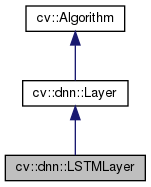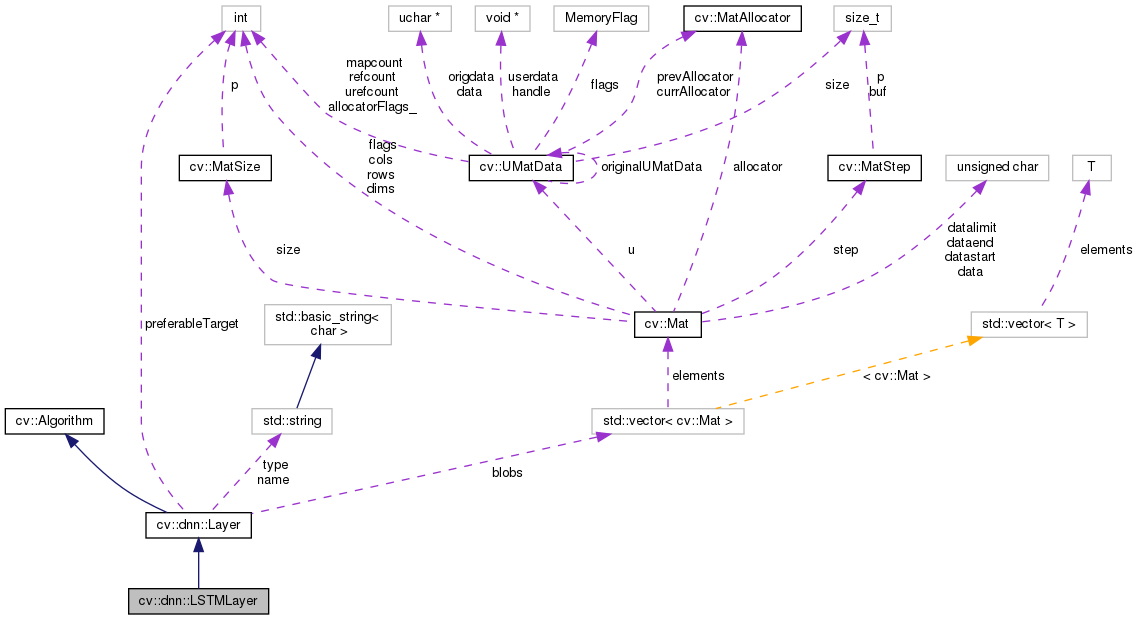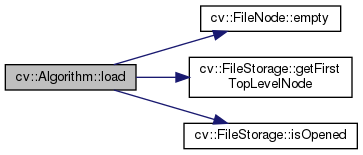LSTM recurrent layer. More...
#include <opencv2/dnn/all_layers.hpp>


Public Member Functions | |
| virtual void | applyHalideScheduler (Ptr< BackendNode > &node, const std::vector< Mat *> &inputs, const std::vector< Mat > &outputs, int targetId) const |
| Automatic Halide scheduling based on layer hyper-parameters. More... | |
| virtual void | clear () |
| Clears the algorithm state. More... | |
| virtual bool | empty () const |
| Returns true if the Algorithm is empty (e.g. More... | |
| virtual void | finalize (const std::vector< Mat *> &input, std::vector< Mat > &output) |
| Computes and sets internal parameters according to inputs, outputs and blobs. More... | |
| virtual void | finalize (InputArrayOfArrays inputs, OutputArrayOfArrays outputs) |
| Computes and sets internal parameters according to inputs, outputs and blobs. More... | |
| void | finalize (const std::vector< Mat > &inputs, std::vector< Mat > &outputs) |
| This is an overloaded member function, provided for convenience. It differs from the above function only in what argument(s) it accepts. More... | |
| std::vector< Mat > | finalize (const std::vector< Mat > &inputs) |
| This is an overloaded member function, provided for convenience. It differs from the above function only in what argument(s) it accepts. More... | |
| virtual void | forward (std::vector< Mat *> &input, std::vector< Mat > &output, std::vector< Mat > &internals) |
Given the input blobs, computes the output blobs. More... | |
| virtual void | forward (InputArrayOfArrays inputs, OutputArrayOfArrays outputs, OutputArrayOfArrays internals) |
Given the input blobs, computes the output blobs. More... | |
| void | forward_fallback (InputArrayOfArrays inputs, OutputArrayOfArrays outputs, OutputArrayOfArrays internals) |
Given the input blobs, computes the output blobs. More... | |
| virtual String | getDefaultName () const |
| Returns the algorithm string identifier. More... | |
| virtual int64 | getFLOPS (const std::vector< MatShape > &inputs, const std::vector< MatShape > &outputs) const |
| virtual bool | getMemoryShapes (const std::vector< MatShape > &inputs, const int requiredOutputs, std::vector< MatShape > &outputs, std::vector< MatShape > &internals) const |
| virtual void | getScaleShift (Mat &scale, Mat &shift) const |
| Returns parameters of layers with channel-wise multiplication and addition. More... | |
| virtual Ptr< BackendNode > | initHalide (const std::vector< Ptr< BackendWrapper > > &inputs) |
| Returns Halide backend node. More... | |
| virtual Ptr< BackendNode > | initInfEngine (const std::vector< Ptr< BackendWrapper > > &inputs) |
| virtual Ptr< BackendNode > | initVkCom (const std::vector< Ptr< BackendWrapper > > &inputs) |
| int | inputNameToIndex (String inputName) CV_OVERRIDE |
| Returns index of input blob into the input array. More... | |
| int | outputNameToIndex (const String &outputName) CV_OVERRIDE |
| Returns index of output blob in output array. More... | |
| virtual void | read (const FileNode &fn) |
| Reads algorithm parameters from a file storage. More... | |
| void | run (const std::vector< Mat > &inputs, std::vector< Mat > &outputs, std::vector< Mat > &internals) |
| Allocates layer and computes output. More... | |
| virtual void | save (const String &filename) const |
| Saves the algorithm to a file. More... | |
| virtual bool | setActivation (const Ptr< ActivationLayer > &layer) |
| Tries to attach to the layer the subsequent activation layer, i.e. More... | |
| virtual void | setOutShape (const MatShape &outTailShape=MatShape())=0 |
Specifies shape of output blob which will be [[T], N] + outTailShape. More... | |
| void | setParamsFrom (const LayerParams ¶ms) |
| Initializes only name, type and blobs fields. More... | |
| virtual void | setProduceCellOutput (bool produce=false)=0 |
| If this flag is set to true then layer will produce \( c_t \) as second output. More... | |
| virtual void | setUseTimstampsDim (bool use=true)=0 |
| Specifies either interpret first dimension of input blob as timestamp dimenion either as sample. More... | |
| virtual void | setWeights (const Mat &Wh, const Mat &Wx, const Mat &b)=0 |
| Set trained weights for LSTM layer. More... | |
| virtual bool | supportBackend (int backendId) |
| Ask layer if it support specific backend for doing computations. More... | |
| virtual Ptr< BackendNode > | tryAttach (const Ptr< BackendNode > &node) |
| Implement layers fusing. More... | |
| virtual bool | tryFuse (Ptr< Layer > &top) |
| Try to fuse current layer with a next one. More... | |
| virtual void | unsetAttached () |
| "Deattaches" all the layers, attached to particular layer. More... | |
| virtual void | write (FileStorage &fs) const |
| Stores algorithm parameters in a file storage. More... | |
| void | write (const Ptr< FileStorage > &fs, const String &name=String()) const |
| simplified API for language bindings This is an overloaded member function, provided for convenience. It differs from the above function only in what argument(s) it accepts. More... | |
Static Public Member Functions | |
| static Ptr< LSTMLayer > | create (const LayerParams ¶ms) |
| Creates instance of LSTM layer. More... | |
| template<typename _Tp > | |
| static Ptr< _Tp > | load (const String &filename, const String &objname=String()) |
| Loads algorithm from the file. More... | |
| template<typename _Tp > | |
| static Ptr< _Tp > | loadFromString (const String &strModel, const String &objname=String()) |
| Loads algorithm from a String. More... | |
| template<typename _Tp > | |
| static Ptr< _Tp > | read (const FileNode &fn) |
| Reads algorithm from the file node. More... | |
Public Attributes | |
| std::vector< Mat > | blobs |
| List of learned parameters must be stored here to allow read them by using Net::getParam(). More... | |
| String | name |
| Name of the layer instance, can be used for logging or other internal purposes. More... | |
| int | preferableTarget |
| prefer target for layer forwarding More... | |
| String | type |
| Type name which was used for creating layer by layer factory. More... | |
Protected Member Functions | |
| void | writeFormat (FileStorage &fs) const |
LSTM recurrent layer.
|
virtualinherited |
Automatic Halide scheduling based on layer hyper-parameters.
| [in] | node | Backend node with Halide functions. |
| [in] | inputs | Blobs that will be used in forward invocations. |
| [in] | outputs | Blobs that will be used in forward invocations. |
| [in] | targetId | Target identifier |
Layer don't use own Halide::Func members because we can have applied layers fusing. In this way the fused function should be scheduled.
|
inlinevirtualinherited |
Clears the algorithm state.
Reimplemented in cv::FlannBasedMatcher, and cv::DescriptorMatcher.
|
static |
Creates instance of LSTM layer.
|
inlinevirtualinherited |
Returns true if the Algorithm is empty (e.g.
in the very beginning or after unsuccessful read
Reimplemented in cv::DescriptorMatcher, cv::ml::StatModel, cv::Feature2D, and cv::BaseCascadeClassifier.
|
virtualinherited |
Computes and sets internal parameters according to inputs, outputs and blobs.
| [in] | input | vector of already allocated input blobs |
| [out] | output | vector of already allocated output blobs |
If this method is called after network has allocated all memory for input and output blobs and before inferencing.
|
virtualinherited |
Computes and sets internal parameters according to inputs, outputs and blobs.
| [in] | inputs | vector of already allocated input blobs |
| [out] | outputs | vector of already allocated output blobs |
If this method is called after network has allocated all memory for input and output blobs and before inferencing.
|
inherited |
This is an overloaded member function, provided for convenience. It differs from the above function only in what argument(s) it accepts.
This is an overloaded member function, provided for convenience. It differs from the above function only in what argument(s) it accepts.
|
virtualinherited |
Given the input blobs, computes the output blobs.
| [in] | input | the input blobs. |
| [out] | output | allocated output blobs, which will store results of the computation. |
| [out] | internals | allocated internal blobs |
|
virtualinherited |
Given the input blobs, computes the output blobs.
| [in] | inputs | the input blobs. |
| [out] | outputs | allocated output blobs, which will store results of the computation. |
| [out] | internals | allocated internal blobs |
|
inherited |
Given the input blobs, computes the output blobs.
| [in] | inputs | the input blobs. |
| [out] | outputs | allocated output blobs, which will store results of the computation. |
| [out] | internals | allocated internal blobs |
|
virtualinherited |
Returns the algorithm string identifier.
This string is used as top level xml/yml node tag when the object is saved to a file or string.
Reimplemented in cv::AKAZE, cv::KAZE, cv::SimpleBlobDetector, cv::GFTTDetector, cv::AgastFeatureDetector, cv::FastFeatureDetector, cv::MSER, cv::ORB, cv::BRISK, and cv::Feature2D.
|
inlinevirtualinherited |
|
virtualinherited |
Returns parameters of layers with channel-wise multiplication and addition.
| [out] | scale | Channel-wise multipliers. Total number of values should be equal to number of channels. |
| [out] | shift | Channel-wise offsets. Total number of values should be equal to number of channels. |
Some layers can fuse their transformations with further layers. In example, convolution + batch normalization. This way base layer use weights from layer after it. Fused layer is skipped. By default, scale and shift are empty that means layer has no element-wise multiplications or additions.
|
virtualinherited |
Returns Halide backend node.
| [in] | inputs | Input Halide buffers. |
Input buffers should be exactly the same that will be used in forward invocations. Despite we can use Halide::ImageParam based on input shape only, it helps prevent some memory management issues (if something wrong, Halide tests will be failed).
|
virtualinherited |
|
virtualinherited |
|
virtual |
Returns index of input blob into the input array.
| inputName | label of input blob |
Each layer input and output can be labeled to easily identify them using "%<layer_name%>[.output_name]" notation. This method maps label of input blob to its index into input vector.
Reimplemented from cv::dnn::Layer.
|
inlinestaticinherited |
Loads algorithm from the file.
| filename | Name of the file to read. |
| objname | The optional name of the node to read (if empty, the first top-level node will be used) |
This is static template method of Algorithm. It's usage is following (in the case of SVM):
In order to make this method work, the derived class must overwrite Algorithm::read(const FileNode& fn).
References CV_Assert, cv::FileNode::empty(), cv::FileStorage::getFirstTopLevelNode(), cv::FileStorage::isOpened(), and cv::FileStorage::READ.

|
inlinestaticinherited |
Loads algorithm from a String.
| strModel | The string variable containing the model you want to load. |
| objname | The optional name of the node to read (if empty, the first top-level node will be used) |
This is static template method of Algorithm. It's usage is following (in the case of SVM):
References CV_WRAP, cv::FileNode::empty(), cv::FileStorage::getFirstTopLevelNode(), cv::FileStorage::MEMORY, and cv::FileStorage::READ.

|
virtual |
Returns index of output blob in output array.
Reimplemented from cv::dnn::Layer.
|
inlinevirtualinherited |
Reads algorithm parameters from a file storage.
Reimplemented in cv::FlannBasedMatcher, cv::DescriptorMatcher, and cv::Feature2D.
|
inlinestaticinherited |
Reads algorithm from the file node.
This is static template method of Algorithm. It's usage is following (in the case of SVM):
In order to make this method work, the derived class must overwrite Algorithm::read(const FileNode& fn) and also have static create() method without parameters (or with all the optional parameters)
|
inherited |
Allocates layer and computes output.
|
virtualinherited |
Saves the algorithm to a file.
In order to make this method work, the derived class must implement Algorithm::write(FileStorage& fs).
|
virtualinherited |
Tries to attach to the layer the subsequent activation layer, i.e.
do the layer fusion in a partial case.
| [in] | layer | The subsequent activation layer. |
Returns true if the activation layer has been attached successfully.
|
pure virtual |
Specifies shape of output blob which will be [[T], N] + outTailShape.
If this parameter is empty or unset then outTailShape = [Wh.size(0)] will be used, where Wh is parameter from setWeights().
|
inherited |
|
pure virtual |
If this flag is set to true then layer will produce \( c_t \) as second output.
use_timestamp_dim in LayerParams.Shape of the second output is the same as first output.
|
pure virtual |
Specifies either interpret first dimension of input blob as timestamp dimenion either as sample.
produce_cell_output in LayerParams.If flag is set to true then shape of input blob will be interpreted as [T, N, [data dims]] where T specifies number of timestamps, N is number of independent streams. In this case each forward() call will iterate through T timestamps and update layer's state T times.
If flag is set to false then shape of input blob will be interpreted as [N, [data dims]]. In this case each forward() call will make one iteration and produce one timestamp with shape [N, [out dims]].
|
pure virtual |
Set trained weights for LSTM layer.
LSTM behavior on each step is defined by current input, previous output, previous cell state and learned weights.
Let \(x_t\) be current input, \(h_t\) be current output, \(c_t\) be current state. Than current output and current cell state is computed as follows:
\begin{eqnarray*} h_t &= o_t \odot tanh(c_t), \\ c_t &= f_t \odot c_{t-1} + i_t \odot g_t, \\ \end{eqnarray*}
where \(\odot\) is per-element multiply operation and \(i_t, f_t, o_t, g_t\) is internal gates that are computed using learned wights.
Gates are computed as follows:
\begin{eqnarray*} i_t &= sigmoid&(W_{xi} x_t + W_{hi} h_{t-1} + b_i), \\ f_t &= sigmoid&(W_{xf} x_t + W_{hf} h_{t-1} + b_f), \\ o_t &= sigmoid&(W_{xo} x_t + W_{ho} h_{t-1} + b_o), \\ g_t &= tanh &(W_{xg} x_t + W_{hg} h_{t-1} + b_g), \\ \end{eqnarray*}
where \(W_{x?}\), \(W_{h?}\) and \(b_{?}\) are learned weights represented as matrices: \(W_{x?} \in R^{N_h \times N_x}\), \(W_{h?} \in R^{N_h \times N_h}\), \(b_? \in R^{N_h}\).
For simplicity and performance purposes we use \( W_x = [W_{xi}; W_{xf}; W_{xo}, W_{xg}] \) (i.e. \(W_x\) is vertical concatenation of \( W_{x?} \)), \( W_x \in R^{4N_h \times N_x} \). The same for \( W_h = [W_{hi}; W_{hf}; W_{ho}, W_{hg}], W_h \in R^{4N_h \times N_h} \) and for \( b = [b_i; b_f, b_o, b_g]\), \(b \in R^{4N_h} \).
| Wh | is matrix defining how previous output is transformed to internal gates (i.e. according to above mentioned notation is \( W_h \)) |
| Wx | is matrix defining how current input is transformed to internal gates (i.e. according to above mentioned notation is \( W_x \)) |
| b | is bias vector (i.e. according to above mentioned notation is \( b \)) |
|
virtualinherited |
Ask layer if it support specific backend for doing computations.
| [in] | backendId | computation backend identifier. |
|
virtualinherited |
Implement layers fusing.
| [in] | node | Backend node of bottom layer. |
Actual for graph-based backends. If layer attached successfully, returns non-empty cv::Ptr to node of the same backend. Fuse only over the last function.
Try to fuse current layer with a next one.
| [in] | top | Next layer to be fused. |
|
virtualinherited |
"Deattaches" all the layers, attached to particular layer.
|
inlinevirtualinherited |
Stores algorithm parameters in a file storage.
Reimplemented in cv::FlannBasedMatcher, cv::DescriptorMatcher, and cv::Feature2D.
References CV_WRAP.
Referenced by cv::Feature2D::write(), and cv::DescriptorMatcher::write().

|
inherited |
simplified API for language bindings This is an overloaded member function, provided for convenience. It differs from the above function only in what argument(s) it accepts.
|
protectedinherited |
|
inherited |
List of learned parameters must be stored here to allow read them by using Net::getParam().
|
inherited |
Name of the layer instance, can be used for logging or other internal purposes.
|
inherited |
prefer target for layer forwarding
|
inherited |
Type name which was used for creating layer by layer factory.